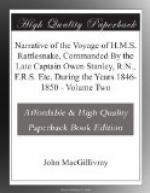(Footnote. This wood was much used in the construction of the pahs which, in 1845, under the Maori chiefs Heke and Kawiti, long resisted the attacks of disciplined forces, aided by artillery. In reference to the puriri wood used in the palisading of one of these, it was officially stated, that “many of our six-pound shot were picked out of the posts, not having actually entered far enough to hide themselves.”)
Returning to the road by a path which avoided the swamps our guide had taken us through, in little more than half an hour we reached Mr. Kemp’s house, and after partaking of that gentleman’s hospitality returned to the ship. On our way we landed at sunset for an hour upon a small island, which will probably long be remembered by some of the party as having furnished us with a supper of very excellent rock-oysters.
Having effected the necessary repairs, and disposed of the decked boat, we left New Zealand on May 22nd on our homeward passage. On July 5th having passed to the eastward of Cape Horn we bore up for the Falkland Islands, having taken forty-three days to traverse a direct distance of a little more than 5000 miles. During this period the wind was usually strong from the south-west, but on various occasions we experienced calms and easterly winds, the latter varying between North-East and South-South-East and at times blowing very hard with snow squalls. The lowest temperature experienced by us off Cape Horn was on the day when we doubled the Cape in latitude 57 degrees South when the minimum temperature of the day was 21 and the maximum 26 degrees. This reminded some of us that we had now passed through not less than 75 degrees of temperature in the ship, the thermometer in the shade having indicated 96 degrees during a hot wind in Sydney harbour.
A passage such as ours, during which at one time we were further from land than if placed in any other portion on the globe, must almost of necessity be a monotonous one. We saw no land, not even an iceberg, and very few vessels. For five or six successive evenings when in the parallels of 40 and 41 degrees South between the meridians of 133 and 113 degrees West we enjoyed the fine sight of thousands of large Pyrosomae in the water, each producing a greater body of light than I ever saw given out by any other of the pelagic-luciferous mollusca or medusae. The towing net was put over on several occasions but produced little or nothing to repay Mr. Huxley for his trouble: so that even a naturalist would here find his occupation gone were it not for the numbers of oceanic birds daily met with, the observation of whose habits and succession of occurrence served to fill up many a leisure hour. It being the winter of the southern hemisphere, the members of the petrel family, at other times so abundant in the South Pacific, were by no means so numerous as I had expected to find them, and in the higher southern latitudes which we attained before rounding Cape Horn, albatrosses




